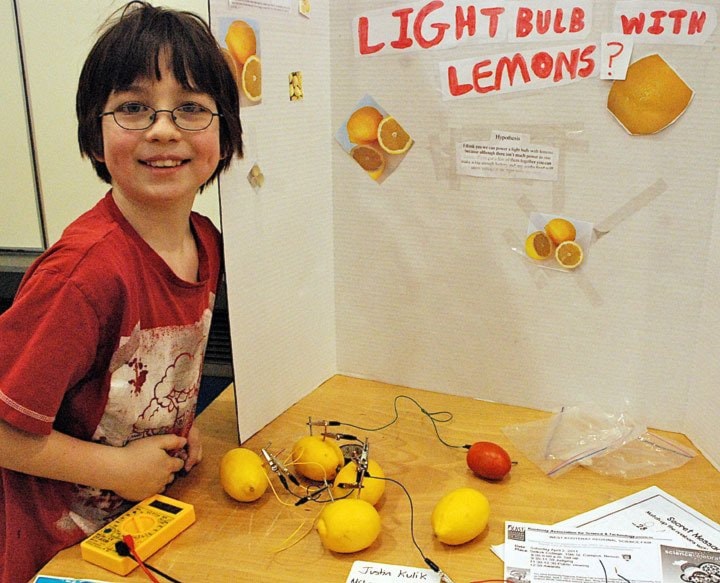(More photos from the science fair are available at: facebook.com/rosslandnews)
The School District 20 Science Fair at Trail Middle School last week drew a wide range of creative talent from around the region, including a great showing by RSS, MacLean Elementary, and École des Sept-Sommets.
Rossland students answered a variety of questions such as: “How do chickens make eggs?” and “What peanut butter do hamsters prefer?”
Students from seven elementary schools — five district and two independent — and two secondary schools entered more than 80 projects that were presented by more than 100 students.
Judges awarded projects in Grades 4, 5, and 6/7, although projects were entered by students from Grade 1 to Grade 11.
Denise Flick, the district learning co-ordinator who was instrumental in organizing the event and has been involved in science fairs in the mid-1990s, said selecting students for awards was very difficult.
“Today was an extraordinary success,” she said. “We have not had this many projects in years.”
“I credit it to a number of champions at different schools, teachers who are champions of science who mentored their students and enabled them to get the resources and organization they needed.
“And, of course, to the parents who are so keenly interested and make it possible for their kids to take part,” she said.
As the judges found, it is difficult to single out projects from such a broad and interesting set of submissions, but one of the highlights included “Can you make amber in one day?” asked by Grade 2 Maclean student Alexander Stone.
Indeed you can, Stone discovered, with nothing more than tree sap, hot water, and olive oil.
Grade 4 students produced a great number of excellent projects.
Favourites included Clare Snelgrove’s “Is double dipping as bad as spitting a mouthful of dip in a bowl?” which she tested with swabs and petri dishes.
Unfortunately, Snelgrove reported that her results were not conclusive due to sample contamination, so the question remains a mystery.
Kathryn Daines, also in Grade 4, asked how chickens make eggs, and took the question to her grandfather’s friend’s farm.
She got down and dirty, dissecting an old hen and matching what she found to information in text books, coming up with a complete story of the egg’s formation.
Her proud grandfather observed: “Now that’s science.”
Justin Kulik presented one of several projects that explored the potential of acidic fruit, such as lemons, to act as a battery and actually light a bulb when pierced with the correct metals and connected in series.
MacLean’s Madeline Kinghorn — “What are the Northern Lights?” — and Samantha Gaul — “What makes popcorn pop?” — tied for third place, and Michel Kristen Hjeltman of the École des Sept-Sommets tied students from other schools for first place among the Grade 4s for her investigation of ice cubes and whether they melt faster in salt or fresh water.
The Grade 5 students did very well also, with Alesha Hall taking third for her work on pulleys, Sophie Wardy in second for looking into how to find your blind spot, and Ali D’Odorico for asking how surface area affects evaporation.
One of the most unique projects was Grade 7 RSS students Sage and Dakota Robine’s investigation of hamster peanut butter preferences.
Unfortunately, one of the two test subjects died of old age part-way through the experiments, and although the other showed a predilection for Adam’s Crunchy, it seemed he was also beginning to develop a taste for Kraft Smooth.
While the Robines took second place, RSS cleaned up first place in the Grade 6/7 category also, with Rachel Aiken’s study of water, and Danelle Farrell and Raeann Lyll’s intrguing question, “Do vitamins help plants grow?”
The next big event is the West Kootenay Regional Science Fair on April 2 at Mary Hall at Selkirk College’s Nelson campus. It’s open for registration for all students in school districts No. 20, 8, 51, and 10, with no prequalification required — i.e., participants are not required to have participated in a local, district-level fair.
The Kootenay Association for Science and Technology (KAST) will give $1,500 of assistance with travel costs for the regional winner who gets to go to the Canada-wide science fair in Toronto later this year.
The regional science fair also features a popsicle bridge building competition, an initiative of the Association of Professional Engineers and Geoscientists of BC (APEGBC). Kids get a standard kit from APEGBC, build a bridge, and bring it in for testing to see how much weight it can hold. Testing is a spectacular affair that involves loading the bridge to the point of collapse.
There’s still time to get involved with the science fair and the popsicle bridge contest. While supplies last, bridge kits are available from KAST — 2196 LeRoi Ave, Rossland, 483-5052 — and more information is available from APEGBC’s Mark Sirges at 250-368-2504.
